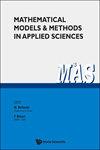Asymptotic behavior of a three-dimensional haptotactic cross-diffusion system modeling oncolytic virotherapy
IF 3
1区 数学
Q1 MATHEMATICS, APPLIED
Mathematical Models & Methods in Applied Sciences
Pub Date : 2022-10-02
DOI:10.1142/s0218202523400043
引用次数: 0
Abstract
This paper deals with an initial-boundary value problem for a doubly haptotactic cross-diffusion system arising from the oncolytic virotherapy \begin{equation*} \left\{ \begin{array}{lll} u_t=\Delta u-\nabla \cdot(u\nabla v)+\mu u(1-u)-uz,\\ v_t=-(u+w)v,\\ w_t=\Delta w-\nabla \cdot(w\nabla v)-w+uz,\\ z_t=D_z\Delta z-z-uz+\beta w, \end{array} \right. \end{equation*} in a smoothly bounded domain $\Omega\subset \mathbb{R}^3$ with $\beta>0$,~$\mu>0$ and $D_z>0$. Based on a self-map argument, it is shown that under the assumption $\beta \max \{1,\|u_0\|_{L^{\infty}(\Omega)}\}<1+ (1+\frac1{\min_{x\in \Omega}u_0(x)})^{-1}$, this problem possesses a uniquely determined global classical solution $(u,v,w,z)$ for certain type of small data $(u_0,v_0,w_0,z_0)$. Moreover, $(u,v,w,z)$ is globally bounded and exponentially stabilizes towards its spatially homogeneous equilibrium %constant equilibrium $(1,0,0,0)$ as $t\rightarrow \infty$.模拟溶瘤病毒治疗的三维触觉交叉扩散系统的渐近行为
本文讨论了由溶瘤病毒治疗引起的双触觉交叉扩散系统的初边值问题\beart{equipment*}\left{\bearth{array}{lll}u _t=\Delta u-\nabla \cdot(u \nabla v)+\mu u(1-u)-uz,\\v_t=-(u+w)v,\\w_t=\Delta w-\nabla\cdot。\在$\beta>0$、~$\mu>0$和$D_z>0$的光滑有界域$\Omega\subet\mathbb{R}^3$中结束{方程*}。基于自映射论点,证明了在假设$\beta\max\{1,\|u_0\|_{L^{\infty}(\Omega)}<1+(1+\frac1{\min_{x\in\Omega}u_0(x)})^{-1}$下,对于某些类型的小数据$(u_0,v_0,w_0,z_0)$,该问题具有唯一确定的全局经典解$(u,v,w,z)$。此外,$(u,v,w,z)$是全局有界的,并且以$t\rightarrow\infty$的形式向其空间齐次平衡%恒定平衡$(1,0,0,0)$指数稳定。
本文章由计算机程序翻译,如有差异,请以英文原文为准。
求助全文
约1分钟内获得全文
求助全文
来源期刊
CiteScore
6.30
自引率
17.10%
发文量
61
审稿时长
1 months
期刊介绍:
The purpose of this journal is to provide a medium of exchange for scientists engaged in applied sciences (physics, mathematical physics, natural, and technological sciences) where there exists a non-trivial interplay between mathematics, mathematical modelling of real systems and mathematical and computer methods oriented towards the qualitative and quantitative analysis of real physical systems.
The principal areas of interest of this journal are the following:
1.Mathematical modelling of systems in applied sciences;
2.Mathematical methods for the qualitative and quantitative analysis of models of mathematical physics and technological sciences;
3.Numerical and computer treatment of mathematical models or real systems.
Special attention will be paid to the analysis of nonlinearities and stochastic aspects.
Within the above limitation, scientists in all fields which employ mathematics are encouraged to submit research and review papers to the journal. Both theoretical and applied papers will be considered for publication. High quality, novelty of the content and potential for the applications to modern problems in applied sciences and technology will be the guidelines for the selection of papers to be published in the journal. This journal publishes only articles with original and innovative contents.
Book reviews, announcements and tutorial articles will be featured occasionally.

 求助内容:
求助内容: 应助结果提醒方式:
应助结果提醒方式:


